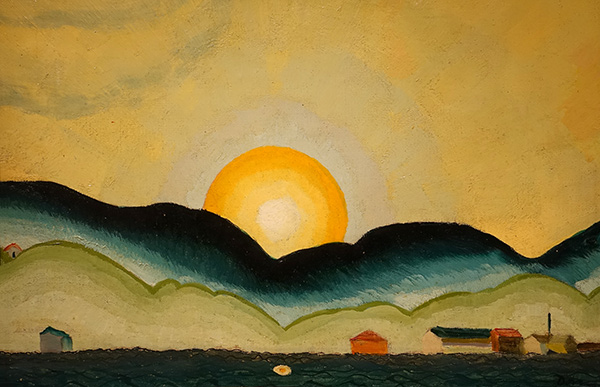Subtotal: $
Checkout
What Makes Poetry Christian?
Our reviewer critiques Christian Poetry in America since 1940, a new anthology edited by Micah Mattix and Sally Thomas.
By Andrew Frisardi
January 5, 2023
The title of this book might lead one to expect a selection of poems stretching back to the 1940s, by American Christian poets such as Richard Wilbur or Wendell Berry, who started publishing at around that time. Instead, this anthology contains the work of Christian poets in America born after 1940, since the senior poet here, Paul Mariani, was born that year. On offer are poems by thirty-five American poets – twenty-one of them born before 1960 (from Mariani to Marjorie Maddox), twelve in the 1960s or 1970s (from Angela Alaimo O’Donnell to Mark Wagenaar), and the last two in the 1980s (Ryan Wilson and Chelsea Wagenaar) – so the selection leans toward the older poets. Some of the poets are well known; some are not. It’s an interesting mix in that regard.
Micah Mattix and Sally Thomas’s editorial choices cover a lot of ground. In terms of poetic technique, about half of the poems are free verse and half metrical, with and without rhyme, by poets whose voices are alternately skeptical, comic, visceral, visionary, chatty, or devotional. With superb biographical and critical prefaces placed before each poet’s work, the anthology provides a substantial introduction to contemporary Christian poetry in America, as well as food for thought and multiple models for where such poetry might go in the future. I discovered poets I wasn’t familiar with and will want to follow up on, and the generous selections (no fewer than two poems per poet and as many as seven) provide readers with a good taste of each poet’s work. One criterion for selection, stated in Mattix’s introduction, was to focus on poems that “treat matters of Christian doctrine and practice directly,” leaving out work which is more implicitly Christian or is spiritual in a less specific sense; though in fact there are some poems that contain no religious doctrine or reference per se.

Arthur Dove, Sunrise, Northport Harbor
The introduction explores what is meant by the phrase “Christian poetry.” Mattix quotes C. S. Lewis: “Boiling an egg is the same process whether you are a Christian or a Pagan” – a poem is a poem regardless of its content or underlying philosophy. So what makes a Christian poem Christian? One idea that Mattix suggests is that contemporary Christian poets have rejected postmodern self-referentiality and deconstruction by “turning to figuration, form, and narrative.” Yet, while some Christian writers certainly have done this, we only have to recall contemporary agnostic poets such as Rhina Espaillat, David Mason, or Aaron Poochigian to see that Christian poets are only part of a wider interest in formalist poetics and narrative. Mattix also says that the “Christian approach to literature,” unlike that of postmodernism, values imitation and tradition over originality and self-expression. Lewis states that, in the Christian view, “an author should never conceive himself as bringing into existence beauty or wisdom which did not exist before, but simply and solely as trying to embody in terms of his own art some reflection of eternal Beauty and Wisdom.” Poet Marly Youmans expresses this in the anthology when she writes that art is “meant for nothing but the beautiful, / … And has no message to deliver / But is the revelation of itself.” This describes premodern aesthetics in general, however, not just Christian aesthetics; no classical or traditional religious account of culture would contest these criteria in favor of a secular philosophy of art for art’s sake. In short, I think Mattix’s working definition of Christian poetry misses the point that the Christian philosophy of art is one expression of a broader metaphysical understanding of art’s relation to reality. In any case, Mattix rightly notes that Christian poetics asserts that a poem’s life is a sign of the higher creative principles at work in the world. So Christian poetry “is inherently double – both surface and depth, material and immaterial.” The poems in this book are accordingly multifaceted and stamped with the poets’ lives, from the psalm-like directness and fluid cadences of the late North Dakotan poet-farmer Timothy Murphy, to the unadorned Mennonite physicality of Pennsylvanian Julia Spicher Kasdorf, to Louisianan Jennifer Reeser’s blend of Anglo-American prosody with Native American prayer and song.
Like most anthologies of contemporary work on any theme – love poems, political poems, Christian poems – the poetic inventiveness and quality of craft fluctuate here. There are masterful and standout poems, and many highly accomplished poems, as well as some that are average contemporary American poetry fare, short on workmanship and vision. I would have preferred fewer poems for certain poets but a greater number of poets overall. Still, all the poets included are ones whose vocation to the word is integral to their spiritual calling, a legacy of the Adamic naming of things. As Dana Gioia puts it in this book, “the stones remain less real to those who cannot / name them.” And as Clare Rossini implies, such naming or poetry is always a kind of prayer: “The window frames a cumulus drifting. / Don’t make me / Speak to clouds.”
Already a subscriber? Sign in
Try 3 months of unlimited access. Start your FREE TRIAL today. Cancel anytime.






